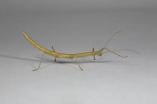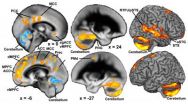(Press-News.org) When they're not hanging upside down, stick insects don't need to stick. In fact, when moving upright, sticking would be a hindrance: so much extra effort required to 'unstick' again with every step.
Latest research from Cambridge's Department of Zoology shows that stick insects have specialised pads on their legs designed to produce large amounts of friction with very little pressure. When upright, stick insects aren't sticking at all, but harnessing powerful friction to ensure they grip firmly without the need to unglue themselves from the ground when they move.
In a previous study last year, the team discovered that stick insects have two distinct types of 'attachment footpads' - the adhesive 'toe pads' at the end of the legs, which are sticky, and the 'heel pads', which are not sticky at all. The insect uses different pads depending on direction and terrain.
By studying the 'heel pads' in more detail, researchers discovered the insects have developed a way to generate massive friction when walking upright. They do this through a system of tiny hairs that use combinations of height and curvature to create a 'hierarchy' of grip, with the slightest pressure generating very strong friction - allowing stick insects to grip but not stick.
The researchers say the study - published today in the Journal of the Royal Society Interface - reveals yet another example of natural engineering successfully combining "desirable but seemingly contradictory properties of man-made materials" - namely, the best of both hard and soft materials - simply through clever structural design.
"Just by arrangement and morphology, nature teaches us that good design means we can combine the properties of hard and soft materials, making elemental forces like friction go a very long way with just a small amount of pressure," said David Labonte, lead researcher from the Department of Zoology.
The power of friction relies on 'contact area', the amount of close contact between surfaces. In rigid materials, such as steel, even the tiniest amount of surface roughness means there is actually relatively little 'contact area' when pressed against other surfaces - so any amount of friction is very small.
On the other hand, soft materials achieve a lot of contact with surfaces, but - due to the larger amount of contact area - there is also a certain amount of adhesion or 'stick' not there with hard materials.
To solve this, stick insect's hairy friction pads employ three main tricks to allow contact area to increase quickly under pressure, creating a scale or 'hierarchy' of grip with absolutely no stick:
Both the pad itself and the tips of the hairs are rounded. This means that, when pressure is applied, more contact area is generated - like pushing down on a rubber ball.
Some hairs are shorter than others, so the more pressure, the more hairs come into contact with the surface.
When even more pressure is applied, some of the hairs bend over and make side contact - greatly increasing contact area with very little extra force.
These design features work in harmony to generate large amounts of friction with comparatively tiny amounts of pressure from the insect. Importantly, there is hardly any contact area without some tiny amount of pressure - which means that the specialised 'frictional hairs' don't stick.
Arrays of tiny hairs have been found before, for example on the feet of geckos, beetles and flies. However, these hairs are designed to stick, and are used when creatures are vertical or hanging upside down.
Sticky hairs are completely aligned and have flat tips - meaning that they immediately make full contact that hardly changes with additional weight - as opposed to friction hairs, with their higgledy-piggledy height ranges and rounded tips.
"We investigate these insects to try and understand biological systems, but lessons from nature such as this might also be useful for inspiring new approaches in man-made devices," said Labonte.
He uses the example of a running shoe as a possible man-made item that could be enhanced by stick insect engineering: "If you run, you don't want your feet to stick to the ground, but you also want to make sure you don't slip."
Adds Labonte: "Stickiness is the force that is needed to overcome when trying to detach one thing from another. If the soles of your feet were made of Scotch tape, it may be helpful when you are walking up walls or hanging upside down, but the rest of the time it would be incredibly frustrating."
"Stick insects have developed an ingenious way of overcoming the conflict between attachment and locomotion, with a dual pad system that alternates between stick and grip depending on the situation."
INFORMATION: END
How stick insects honed friction to grip without sticking
2014-02-19
ELSE PRESS RELEASES FROM THIS DATE:
Addicted to tanning?
2014-02-19
BOWLING GREEN, O.—They keep tanning, even after turning a deep brown and experiencing some of the negative consequences. Skin cancer is among the most common, preventable types of the disease, yet many continue to tan to excess.
Research from Lisham Ashrafioun, a Bowling Green State University Ph.D. student in psychology, and Dr. Erin Bonar, an assistant professor of psychiatry at the University of Michigan Addiction Research Center and a BGSU alumna, shows that some who engage in excessive tanning may also be suffering from obsessive-compulsive (OCD) and body dysmorphic ...
A forgotten model of the universe
2014-02-19
A paper published in EPJ H provides the first English translation and an analysis of one of Albert Einstein's little-known papers, "On the cosmological problem of the general theory of relativity." Published in 1931, it features a forgotten model of the universe, while refuting Einstein's own earlier static model of 1917. In this paper, Einstein introduces a cosmic model in which the universe undergoes an expansion followed by a contraction. This interpretation contrasts with the monotonically expanding universe of the widely known Einstein-de Sitter model of 1932.
The ...
Family problems experienced in childhood and adolescence affect brain development
2014-02-19
New research has revealed that exposure to common family problems during childhood and early adolescence affects brain development, which could lead to mental health issues in later life.
The study led by Dr Nicholas Walsh, lecturer in developmental psychology at the University of East Anglia (UEA), used brain imaging technology to scan teenagers aged 17-19. It found that those who experienced mild to moderate family difficulties between birth and 11 years of age had developed a smaller cerebellum, an area of the brain associated with skill learning, stress regulation ...
Minor added benefit of indacaterol/glycopyrronium in COPD
2014-02-19
The drug combination indacaterol/glycopyrronium (trade name: Ultibro Breezhaler, Xoterna Breezhaler) has been approved since September 2013 for adults with chronic obstructive pulmonary disease (COPD). In an early benefit assessment pursuant to the Act on the Reform of the Market for Medicinal Products (AMNOG), the German Institute for Quality and Efficiency in Health Care (IQWiG) examined whether this drug combination offers an added benefit over the appropriate comparator therapy.
According to the findings, the drug combination is better at relieving breathing difficulties ...
Afatinib: Added benefit depends on mutation status
2014-02-19
Afatinib (trade name: GIOTRIF) has been approved in Germany since September 2013 for the treatment of adult patients with locally advanced or metastatic non-small cell lung cancer (NSCLC) with activating EGF receptor mutations who have not been treated with an EGF receptor tyrosine-kinase inhibitor (EGFR TKI). In an early benefit assessment pursuant to the Act on the Reform of the Market for Medicinal Products (AMNOG), the German Institute for Quality and Efficiency in Health Care (IQWiG) examined whether this new drug offers an added benefit over the appropriate comparator ...
Scientists identify 'long distance scanner' for DNA damage
2014-02-19
Scientists at the University of Bristol have discovered that a mechanism for preventing mutation within important genes involves long distance scanning of DNA by a molecular motor protein.
The results, published in the Proceedings of the National Academy of Sciences (PNAS), show that the method for detecting DNA damage within active genes is more sophisticated than previously thought.
The research team hope that the mechanistic insights provided by this study will help to explain the complicated genome-wide patterns of mutation that underlie the evolution of new species, ...
The nose knows in asthma
2014-02-19
It has become increasingly clear in recent years that asthma comes in several variations, with different causes, different pathologies and different responses to therapy. These subtypes of asthma can be identified by knowing which genes are expressed at higher and lower levels in patients' airways. That information can, in turn, help guide personalized treatment to more effectively manage asthma and inspire research to better understand, manage, and possibly prevent asthma.
The difficulty is that tissue samples necessary for this kind of genetic profiling are currently ...
Diamonds in the tail of the scorpion
2014-02-19
Messier 7, also known as NGC 6475, is a brilliant cluster of about 100 stars located some 800 light-years from Earth. In this new picture from the Wide Field Imager on the MPG/ESO 2.2-metre telescope it stands out against a very rich background of hundreds of thousands of fainter stars, in the direction of the centre of the Milky Way.
At about 200 million years old, Messier 7 is a typical middle-aged open cluster, spanning a region of space about 25 light-years across. As they age, the brightest stars in the picture — a population of up to a tenth of the total stars in ...
Pond-dwelling powerhouse's genome points to its biofuel potential
2014-02-19
Duckweed is a tiny floating plant that's been known to drive people daffy. It's one of the smallest and fastest-growing flowering plants that often becomes a hard-to-control weed in ponds and small lakes. But it's also been exploited to clean contaminated water and as a source to produce pharmaceuticals. Now, the genome of Greater Duckweed (Spirodela polyrhiza) has given this miniscule plant's potential as a biofuel source a big boost. In a paper published February 19, 2014 in the journal Nature Communications, researchers from Rutgers University, the Department of Energy ...
New study reveals communications potential of graphene
2014-02-19
Providing secure wireless connections and improving the efficiency of communication devices could be another application for graphene, as demonstrated by scientists at Queen Mary University of London and the Cambridge Graphene Centre.
Often touted as a wonder material, graphene is a one-atom thick layer of carbon with remarkable, record breaking properties. Until now its ability to absorb electromagnetic radiation – energy from across the radio frequency spectrum – was not known.
Publishing in the journal Scientific Reports, the scientists demonstrated that the transparent ...




